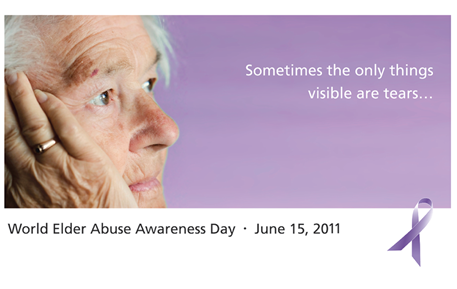 World Elder Abuse Awareness Day involves activities to bring greater recognition of mistreatment of older adults wherever they live throughout the world, and to highlight the need for appropriate action. It is intended to give abuse and neglect of older adults a global relevance that will sustain and move prevention efforts for-ward throughout the whole year and years to come.
World Elder Abuse Awareness Day involves activities to bring greater recognition of mistreatment of older adults wherever they live throughout the world, and to highlight the need for appropriate action. It is intended to give abuse and neglect of older adults a global relevance that will sustain and move prevention efforts for-ward throughout the whole year and years to come.
Throughout the world, abuse and neglect of older adults largely remains under-recognized, or treated as an unspoken problem. No community or country in the world is immune from this social problem.
Abuse and neglect of older adults is a complex and multi-faceted problem. Elder abuse encompasses many different types of harms and can occur in domestic, community or institutional settings.
Raising awareness of elder abuse is a challenge. The issue requires complex, mul-tiple and integrated responses from a very wide range of sources at individual, institutional, societal and global levels.
The United Nations has noted that the world needs a global response to the problem, one which focuses on protecting the rights of older persons.
Every person-every man, woman, and child-deserves to be treated with respect and with caring. Every person-no matter how young or how old-deserves to be safe from harm by those who live with them, care for them, or come in day-to-day contact with them.
Older people today are more visible, more active, and more independent than ever before. They are living longer and in better health. But as the population of older Americans grows, so does the hidden problem of elder abuse, exploitation, and neglect.
Every year an estimated 2.1 million older Americans are victims of physical, psychological, or other forms of abuse and neglect. Those statistics may not tell the whole story. For every case of elder abuse and neglect that is reported to authorities, experts estimate that there may be as many as five cases that have not been reported. Recent research suggests that elders who have been abused tend to die earlier than those who are not abused, even in the absence of chronic conditions or life threatening disease.
Agnes, 85 years old, lost her husband last year. Because of her own problems with arthritis and congestive heart failure, Agnes moved in with her 55-year-old daughter, Emily. The situation is difficult for all of them. Sometimes Emily feels as if she’s at the end of her rope, caring for her mother, worrying about her college-age son and about her husband, who is about to be forced into early retirement. Emily has caught herself calling her mother names and accusing her mother of ruining her life. Recently, she lost her temper and slapped her mother. In addition to feeling frightened and isolated, Agnes feels trapped and worthless.
Like other forms of abuse, elder abuse is a complex problem, and it is easy for people to have misconceptions about it. Many people who hear “elder abuse and neglect” think about older people living in nursing homes or about elderly relatives who live all alone and never have visitors. But elder abuse is not just a problem of older people living on the margins of our everyday life. It is right in our midst:
- Most incidents of elder abuse don’t happen in a nursing home. Occasionally, there are shocking reports of nursing home residents who are mistreated by the staff. Such abuse does occur-but it is not the most common type of elder abuse. At any one time, only about 4 percent of older adults live in nursing homes, and the vast majority of nursing home residents have their physical needs met without experiencing abuse or neglect.
- Most elder abuse and neglect takes place at home. The great majority of older people live on their own or with their spouses, children, siblings, or other relatives-not in institutional settings. When elder abuse happens, family, other household members, and paid caregivers usually are the abusers. Although there are extreme cases of elder abuse, often the abuse is subtle, and the distinction between normal interpersonal stress and abuse is not always easy to discern.
- There is no single pattern of elder abuse in the home. Sometimes the abuse is a continuation of long-standing patterns of physical or emotional abuse within the family. Perhaps, more commonly, the abuse is related to changes in living situations and relationships brought about by the older person’s growing frailty and dependence on others for companionship and for meeting basic needs.
- It isn’t just infirm or mentally impaired elderly people who are vulnerable to abuse. Elders who are ill, frail, disabled, mentally impaired, or depressed are at greater risk of abuse, but even those who do not have these obvious risk factors can find themselves in abusive situations and relationships.
Elder abuse, like other forms of violence, is never an acceptable response to any problem or situation, however stressful. Effective interventions can prevent or stop elder abuse. By increasing awareness among physicians, mental health professionals, home health care workers, and others who provide services to the elderly and family members, patterns of abuse or neglect can be broken, and both the abused person and the abuser can receive needed help. Curious ? Continue Reading
Source: American Psychological Association International Network for the Prevention of Elder Abuse
